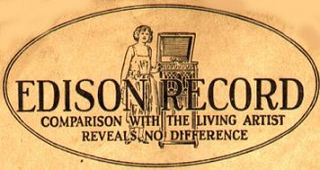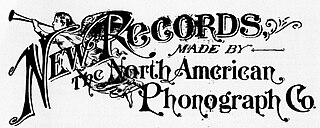
A phonograph, in its later forms also called a gramophone or since the 1940s called a record player, is a device for the mechanical recording and reproduction of sound. The sound vibration waveforms are recorded as corresponding physical deviations of a spiral groove engraved, etched, incised, or impressed into the surface of a rotating cylinder or disc, called a "record". To recreate the sound, the surface is similarly rotated while a playback stylus traces the groove and is therefore vibrated by it, very faintly reproducing the recorded sound. In early acoustic phonographs, the stylus vibrated a diaphragm which produced sound waves which were coupled to the open air through a flaring horn, or directly to the listener's ears through stethoscope-type earphones.

Thomas Alva Edison was an American inventor and businessman who has been described as America's greatest inventor. He developed many devices in fields such as electric power generation, mass communication, sound recording, and motion pictures. These inventions, which include the phonograph, the motion picture camera, and early versions of the electric light bulb, have had a widespread impact on the modern industrialized world. He was one of the first inventors to apply the principles of organized science and teamwork to the process of invention, working with many researchers and employees. He established the first industrial research laboratory.

Phonograph cylinders are the earliest commercial medium for recording and reproducing sound. Commonly known simply as "records" in their era of greatest popularity, these hollow cylindrical objects have an audio recording engraved on the outside surface, which can be reproduced when they are played on a mechanical cylinder phonograph. In the 1910s, the competing disc record system triumphed in the marketplace to become the dominant commercial audio medium.
The Gramophone Company Limited , based in the United Kingdom and founded on behalf of Emil Berliner, was one of the early recording companies, the parent organisation for the His Master's Voice (HMV) label, and the European affiliate of the American Victor Talking Machine Company. Although the company merged with the Columbia Graphophone Company in 1931 to form Electric and Musical Industries Limited (EMI), its name "The Gramophone Company Limited" continued in the UK into the 1970s.

Edison Records was one of the early record labels that pioneered sound recording and reproduction, and was an important player in the early recording industry.

Blue Amberol Records was the trademark name for cylinder records manufactured by Thomas A. Edison, Inc. in the US from 1912 to 1929. They replaced the 4-minute black wax Amberol cylinders introduced in 1908, which had replaced the 2-minute wax cylinders that had been the standard format since the late 1880s. Blue Amberols can play for as long as 4 minutes and 45 seconds and have a surface layer of the "indestructible" plastic celluloid, which Edison tinted a trademark blue color. Edison brand phonographs designed to play Amberol cylinders were named Amberolas.

The Edison Diamond Disc Record is a type of phonograph record marketed by Thomas A. Edison, Inc. on their Edison Record label from 1912 to 1929. They were named Diamond Discs because the matching Edison Disc Phonograph was fitted with a permanent conical diamond stylus for playing them. Diamond Discs were incompatible with lateral-groove disc record players, e.g. the Victor Victrola, the disposable steel needles of which would damage them while extracting hardly any sound. Uniquely, they are just under 1⁄4 in thick.

The Graphophone was the name and trademark of an improved version of the phonograph. It was invented at the Volta Laboratory established by Alexander Graham Bell in Washington, D.C., United States.

The Edison Storage Battery Company was organized in New Jersey on May 27, 1901, to develop, manufacture, and sell the Thomas A Edison, Inc Edison Storage Battery Division label.

Toastmaster is a brand name for home appliances. It was originally (1921) the name of one of the world's first automatic electric toasters for home use, the Toastmaster Model 1-A-1. Since then the Toastmaster brand has been used on a wide range of small kitchen appliances, such as coffeemakers, waffle irons, toasters, and blenders.

The Edison Manufacturing Company was a company organized in 1889 by the inventor and entrepreneur Thomas Edison that manufactured batteries, machinery and equipment, and also produced kinetoscope films. Its assets and operations were transferred to Thomas A. Edison, Inc. in 1911.

Canadian General Electric was a Canadian manufacturer of various electrical products. It was the Canadian counterpart of the American company General Electric. The unit became General Electric Canada in 1989, and is now known as GE Canada.

The Edison Machine Works was a manufacturing company set up to produce dynamos, large electric motors, and other components of the electrical illumination system being built by Thomas A. Edison in New York City.

The Edison–Lalande cell was a type of alkaline primary battery developed by Thomas Edison from an earlier design by Felix Lalande and Georges Chaperon. It consisted of plates of copper oxide and zinc in a solution of potassium hydroxide. The cell voltage was low but the internal resistance was also low so these cells were capable of delivering large currents.
McGraw-Edison was an American manufacturer of electrical equipment. It was created in 1957 through a merger of McGraw Electric and Thomas A. Edison, Inc., and was in turn acquired by Cooper Industries in 1985. Today, the McGraw-Edison brand is used on industrial, commercial, and institutional lighting products.

Max McGraw was an American entrepreneur who founded McGraw-Edison and Centel. He financed marketing of the first domestic toaster, the Toastmaster. He was also a conservationist and hunter.
The McGraw Electric Company was a US manufacturer of electric appliances founded by Max McGraw in 1900. It grew through mergers and acquisitions to become a major enterprise. The best known product may have been the Toastmaster pop-up toaster. In 1957 McGraw Electric merged with Thomas A. Edison, Inc. to form McGraw-Edison.

The North American Phonograph Company was an early attempt to commercialize the maturing technologies of sound recording in the late 1880s and early 1890s. Though the company was largely unsuccessful in its goals due to legal, technical and financial problems, it set the stage for the modern recording industry in the mid 1890s.
















